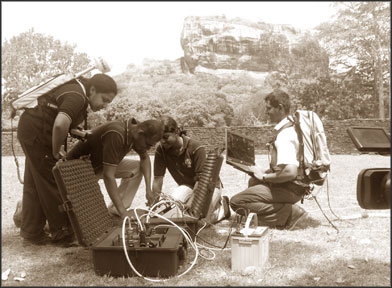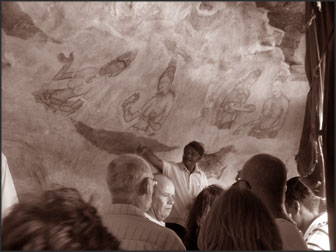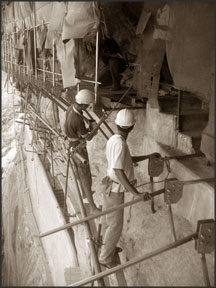|
Top notch techniques used in restoration and
investigation work:
Ancient Sigiriya going high-tech
by Sajitha PREMATUNGE
 |
|
Minister of Environment
and Natural Resources, Patali Champika Ranawaka |
|

Prof. D.M.D.O.K. Dissanayake, Director, GSMB. |
"Sigiriya", what comes to mind, World Heritage site, ancient rock
fortress, 5th Century A.D. frescoes or major tourist attraction? But did
the word "high-tech" ever cross your mind? Well, the restoration work in
Sigiriya is sure going high-tech.
The Geological Survey and Mines Bureau (GSMB), which used to be
considered as a government authority handing out permits for mining has
been the silent force behind making Sigiriya a safer place, for its
invaluable archaeological treasures as well as travellers. The initial
restoration project in Sigiriya has been a result of a request made by
Prof. Shiran Deraniyagala over ten years ago. Special attention has been
paid to possible threat to historical monuments and safety of visitors
due to potential unfavourable geological anomalies in the detailed
investigation and restoration projects on the Sigiriya rock fortress
which in total costs Rs. 50 million conducted by the GSMB, under the
Ministry of Environment and Natural Resources, on request of Central
Cultural Fund (CCF).
A project which comprised four stages has been completed and another
JICA funded project has just commenced. It was evident that the
restoration process was going as planned, on schedule. A dilapidated
metal bridge that was constructed in 1930s has been replaced with a
stainless steel bridge. "It has been burnt to prevent glare", said R.
Madanagala, Senior Technical Officer, GSMB. Under the new JICA project
access to fresco pockets is being widened, fractured and partly loose
rock slabs have been removed or split, widening the flights of stairs,
etc."
GSMB officials explained that only the least invasive methods are
used in the restoration process. Earlier iron wedges were used to hold
nails in place, but iron is subject to decay.
|

GSMB staff operating the Resistivity Imaging System |
Now making use of more scientific methods, stainless steel nails
driven into the rock surface are held in place by special glue. "No
drilling machines are used and even the level of vibration is measured,
to minimize the effects to the rock", explained Prof. D.M.D.O.K.
Dissanayake, Director, GSMB. Geophysics is playing a major role in the
restoration and investigation work at the Sigiriya rock fortress,
conducted by the GSMB. Earlier attempts at detecting buried
archaeological sites have not been successful because the methods used
were low tech, explained Nalin de Silva, GSMB Geophysicist. The new ones
month pilot project, which will cost the GSMB Rs. 88,000, will make use
of a new technique called Ground Penetrating Radar.
This Resistivity Imaging System will send an electric surge of up to
100 k Ohm into the ground using two electrodes; Nalin De Silva explained
the procedure. "One salient feature when studying the patterns of the
archaeological discoveries made is that the ancient structures on either
side of the main path leading to the rock fortress makes a mirror
image", which means that the buildings on either side are similar.
This makes pinpointing ancient structures all the more easier. Nalin
de Silva pointed out that the Sigiriya Rock itself is not an independent
boulder and that this method can also be used to detect how deep the
bedrock which Sigiriya belongs to lies.
The information collected by the high-tech Resistivity Imaging System
is then converted to a 3D program. "This is the first time we have ever
been able to observe any information in 3D", said Nalin de Silva. He
further explained that they hope to scan 16 12X12m squares. This site is
very near surface, around 2 to 3 m.
|

The whole fresco pocket will soon be accessible to the public |
Nalin de Silva explained that these high-tech methods have shed much
needed light on the Sigiriya excavation process.
|

Restoration in progress |
"Geophysics has been used to assist excavation in countries like
Cambodia and Egypt", he said. "A preliminary survey is important in any
well planned excavation." He assured that this new method of exploration
in a non invasive method.
The information collected will be handed over to the Archaeological
Department, revealed Prof. D.M.D.O.K. Dissanayake. "Earlier
archaeologists just excavated till they found something, this method is
much less invasive. In fact this technique has already been used to
identify and pinpoint the location of the prehistoric burial grounds
near Sigiriya and proved so promising that it will be used in many
archaeological projects to come".
Minister of Environment and Natural Resources, Patali Champika
Ranawaka pointed out that the Ministry of Cultural Affairs and the
Archaeology Department has the fullest cooporetion of the GSMB and
Ministry of Environment in the investigation and restoration process of
such an archaeological and engineering marvel. "Caves containing
frescoes that were earlier inaccessible will be accessible to the public
at the end of the restoration process in five months", said the
Minister. "The observation space in the fresco pocket was very limited
and the platform has been corroded", said Prof. D.M.D.O.K. Dissanayake.
As a result only a limited area was open to the public.
The Minister pointed out that significant discoveries have been made
by GSMB engineers during the restoration process, such as the discovery
of frescoes and graffiti on the opposite side of the Mirror Wall.
"A grave threat to the Mirror Wall posed by the unstable rocks above
has already been eliminated by our engineers", explained the Minister.
"Scientific methods such as the Ground Penetrating Radar eliminate
the need for haphazard excavation", he explained. "We can pinpoint the
exact location that needs to be excavated." Consequently, this is a
non-invasive method imposing least disturbance on the sensitive and
priceless archaeological site. "We plan to use the same method in other
archaeological sites in the country, such as Anuradhapura", he explained
that scientifically sound methods were used and the investigation and
said that it was a matter of pride that the restoration process was
conducted with the help of national expertise and engineers.
|

